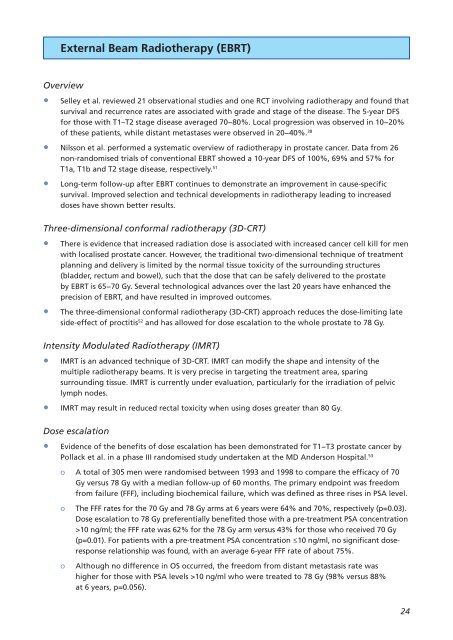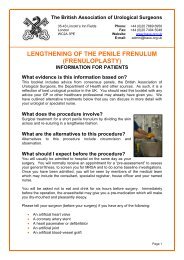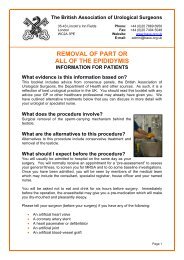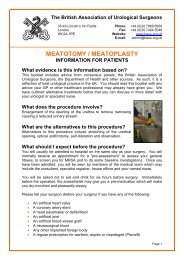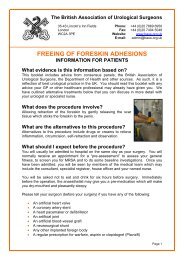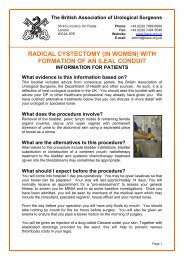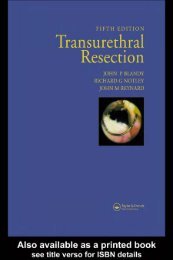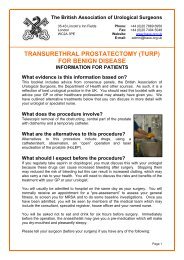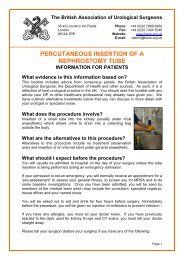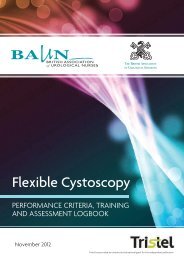MDT (multi-disciplinary team) guidance for managing prostate cancer
MDT (multi-disciplinary team) guidance for managing prostate cancer
MDT (multi-disciplinary team) guidance for managing prostate cancer
Create successful ePaper yourself
Turn your PDF publications into a flip-book with our unique Google optimized e-Paper software.
External Beam Radiotherapy (EBRT)<br />
Overview<br />
• Selley et al. reviewed 21 observational studies and one RCT involving radiotherapy and found that<br />
survival and recurrence rates are associated with grade and stage of the disease. The 5-year DFS<br />
<strong>for</strong> those with T1–T2 stage disease averaged 70−80%. Local progression was observed in 10−20%<br />
of these patients, while distant metastases were observed in 20−40%. 38<br />
• Nilsson et al. per<strong>for</strong>med a systematic overview of radiotherapy in <strong>prostate</strong> <strong>cancer</strong>. Data from 26<br />
non-randomised trials of conventional EBRT showed a 10-year DFS of 100%, 69% and 57% <strong>for</strong><br />
T1a, T1b and T2 stage disease, respectively. 51<br />
• Long-term follow-up after EBRT continues to demonstrate an improvement in cause-specific<br />
survival. Improved selection and technical developments in radiotherapy leading to increased<br />
doses have shown better results.<br />
Three-dimensional con<strong>for</strong>mal radiotherapy (3D-CRT)<br />
• There is evidence that increased radiation dose is associated with increased <strong>cancer</strong> cell kill <strong>for</strong> men<br />
with localised <strong>prostate</strong> <strong>cancer</strong>. However, the traditional two-dimensional technique of treatment<br />
planning and delivery is limited by the normal tissue toxicity of the surrounding structures<br />
(bladder, rectum and bowel), such that the dose that can be safely delivered to the <strong>prostate</strong><br />
by EBRT is 65−70 Gy. Several technological advances over the last 20 years have enhanced the<br />
precision of EBRT, and have resulted in improved outcomes.<br />
• The three-dimensional con<strong>for</strong>mal radiotherapy (3D-CRT) approach reduces the dose-limiting late<br />
side-effect of proctitis 52 and has allowed <strong>for</strong> dose escalation to the whole <strong>prostate</strong> to 78 Gy.<br />
Intensity Modulated Radiotherapy (IMRT)<br />
• IMRT is an advanced technique of 3D-CRT. IMRT can modify the shape and intensity of the<br />
<strong>multi</strong>ple radiotherapy beams. It is very precise in targeting the treatment area, sparing<br />
surrounding tissue. IMRT is currently under evaluation, particularly <strong>for</strong> the irradiation of pelvic<br />
lymph nodes.<br />
• IMRT may result in reduced rectal toxicity when using doses greater than 80 Gy.<br />
Dose escalation<br />
• Evidence of the benefits of dose escalation has been demonstrated <strong>for</strong> T1−T3 <strong>prostate</strong> <strong>cancer</strong> by<br />
Pollack et al. in a phase III randomised study undertaken at the MD Anderson Hospital. 53<br />
o A total of 305 men were randomised between 1993 and 1998 to compare the efficacy of 70<br />
Gy versus 78 Gy with a median follow-up of 60 months. The primary endpoint was freedom<br />
from failure (FFF), including biochemical failure, which was defined as three rises in PSA level.<br />
o The FFF rates <strong>for</strong> the 70 Gy and 78 Gy arms at 6 years were 64% and 70%, respectively (p=0.03).<br />
Dose escalation to 78 Gy preferentially benefited those with a pre-treatment PSA concentration<br />
>10 ng/ml; the FFF rate was 62% <strong>for</strong> the 78 Gy arm versus 43% <strong>for</strong> those who received 70 Gy<br />
(p=0.01). For patients with a pre-treatment PSA concentration ≤10 ng/ml, no significant doseresponse<br />
relationship was found, with an average 6-year FFF rate of about 75%.<br />
o Although no difference in OS occurred, the freedom from distant metastasis rate was<br />
higher <strong>for</strong> those with PSA levels >10 ng/ml who were treated to 78 Gy (98% versus 88%<br />
at 6 years, p=0.056).<br />
24


